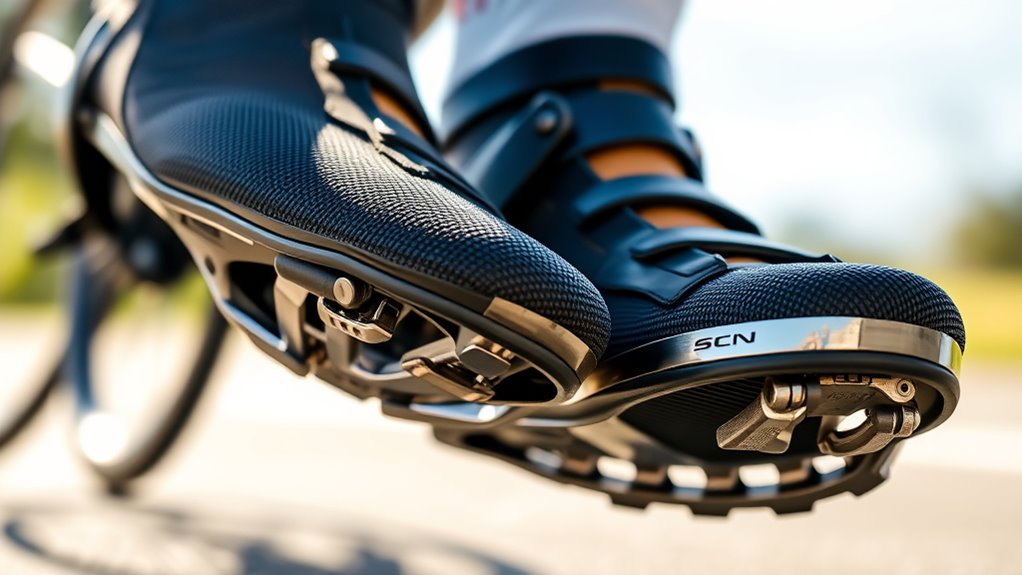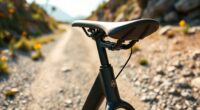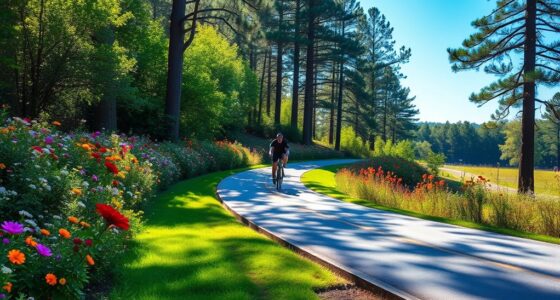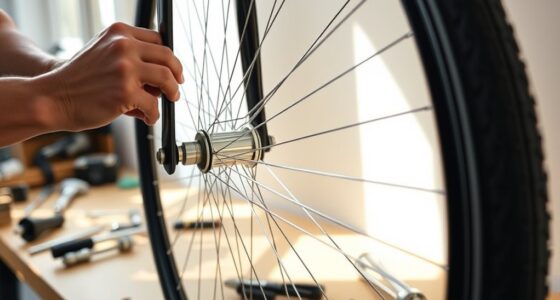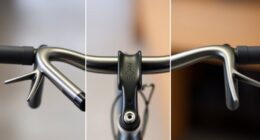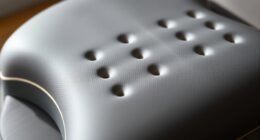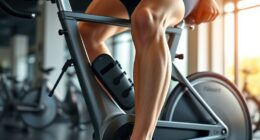To choose clipless pedals without regret, first assess your riding style and goals, ensuring the pedals match your terrain and comfort needs. Understand the different types—road, mountain, SPD—and pick one that suits your shoe compatibility and riding habits. Consider pedal platform size, engagement ease, and adjustable tension for confidence. Balance weight, durability, and personal preference. Setting a realistic budget and testing options helps you find the best fit—exploring more will help you make an informed choice.
Key Takeaways
- Assess your riding style, terrain, and goals to select pedals that match your comfort and efficiency needs.
- Understand different pedal types, cleat systems, and float options to find what suits your confidence and riding preferences.
- Consider pedal platform size, engagement mechanism, and tension adjustability for ease of clipping in and out.
- Balance weight, durability, and material quality to match your riding frequency and conditions.
- Test various pedals to determine the feel and fit, ensuring compatibility with your shoes and bike before committing.
Assess Your Riding Style and Goals
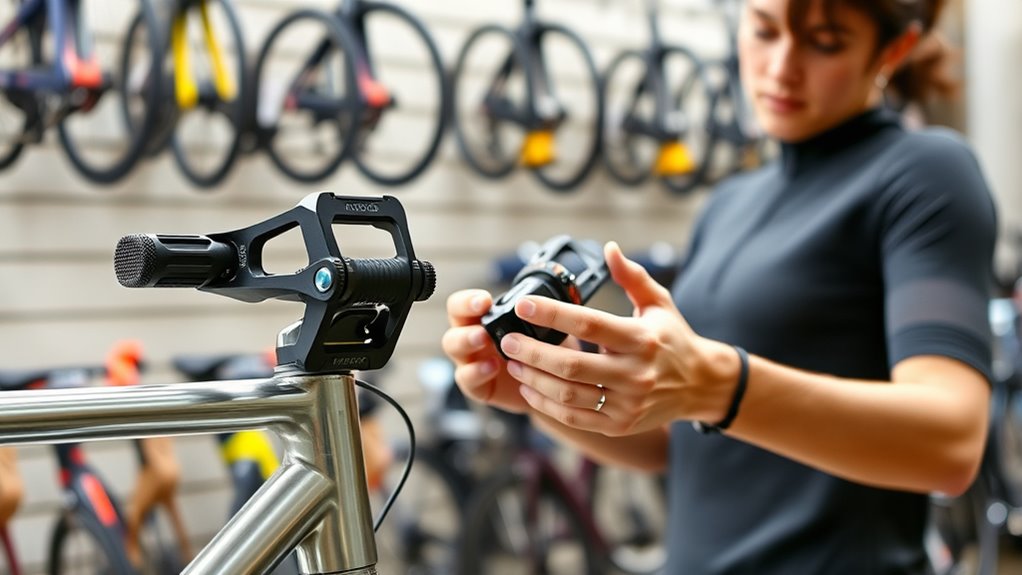
Before choosing clipless pedals, you should clearly assess your riding style and goals, as these factors directly influence the type of pedal that will suit you best. If you prioritize long-distance rides, comfort and pedal efficiency become essential for reducing fatigue and maintaining stamina. For mountain biking or aggressive riding, you might favor pedals that offer a secure connection without sacrificing maneuverability. Consider how you prefer to sit and move on your bike—if comfort matters most, look for pedals that promote a natural foot position. Clarifying your goals helps you select pedals that enhance cycling comfort and maximize pedal efficiency, ensuring a smoother ride aligned with your riding ambitions. Taking this step helps prevent regrets and guides you toward the most suitable clipless pedal choice. Additionally, understanding your growth mindset can help you adapt to new equipment and improve your riding skills over time, as it encourages resilience and continuous learning in the face of challenges. Recognizing the importance of comfort and support in your footwear choices can also contribute to a more enjoyable riding experience.
Understand Different Types of Clipless Pedals
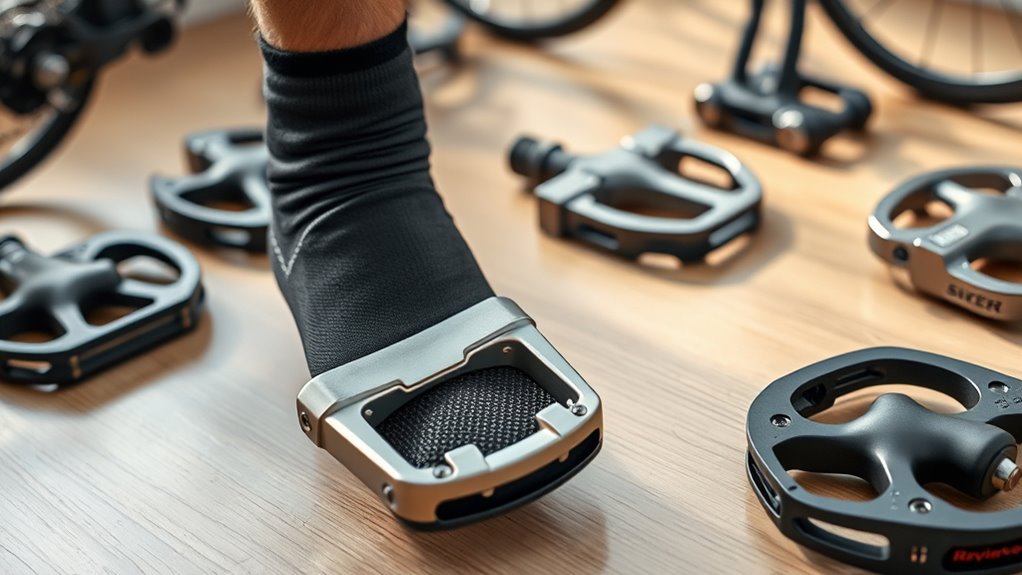
Understanding the differences between road and mountain pedals helps you choose what suits your riding. You’ll also want to compare SPD and Look systems to find the clipless setup that fits your needs. Let’s explore how each type performs and what makes them unique. Additionally, knowing the return policies of retailers can be helpful if you decide to try out different pedals and need to make exchanges or returns. Considering the types of terrain you frequently ride on can also influence your decision, ensuring you select pedals that enhance safety and comfort during your outdoor adventures. Moreover, understanding projector technology can help you better appreciate the features of high-quality cycling equipment, such as adjustable cleats and sole compatibility, which are crucial for a comfortable ride. Exploring the variety of nail styles can also inspire you to personalize your look while ensuring your choices complement your overall style and comfort preferences. When choosing pedals, researching the aura colors associated with different riding styles can provide insights into the energy and passion you bring to your cycling experience.
Road vs. Mountain Pedals
When choosing between road and mountain clipless pedals, it’s important to contemplate how you’ll use your bike and the terrain you’ll ride on. Road pedals typically offer a more streamlined design, enhancing pedal aesthetics and providing a more efficient power transfer. They encourage a forward-tilted cycling posture, which benefits speed and endurance on paved surfaces. Mountain pedals, on the other hand, are built for durability and grip, often featuring larger platforms and easier engagement mechanisms suited for technical trails. They promote a more upright cycling posture, offering better control on uneven terrain. Consider your riding style: if you prioritize speed and sleek looks, road pedals are ideal. For rugged terrain and versatility, mountain pedals will serve you better.
SPD vs. Look System
Choosing the right clipless pedal system hinges on knowing the differences between popular options like SPD and Look. SPD pedals, often used by mountain bikers and commuters, feature a smaller, recessed cleat that offers easier engagement and better walkability. They typically allow for adjustable pedal tension, so you can customize how much force is needed to clip in or out. Look pedals, favored by road cyclists, have a larger, more prominent cleat that provides increased power transfer. However, cleat compatibility can be more restrictive, and the engagement might require more pedal tension adjustment. Your choice depends on your riding style and comfort preferences. If you prefer easier clipping and walking, SPD is a solid choice. For maximum power and efficiency, Look might suit you better.
Check Compatibility With Your Shoes and Bike
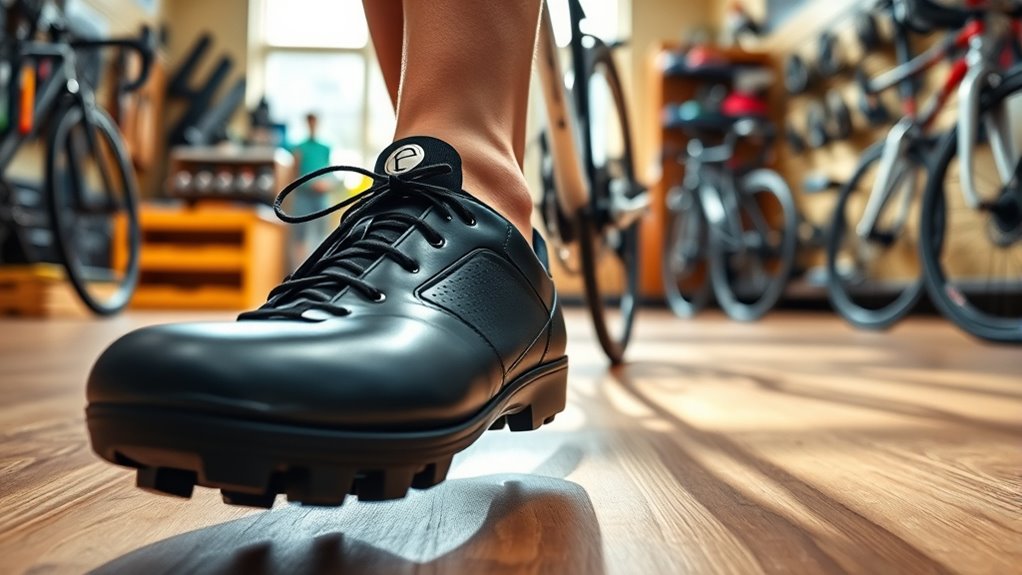
Before purchasing clipless pedals, you need to guarantee they’re compatible with both your shoes and your bike. Conduct a thorough compatibility check to ensure your shoes can clip into the pedals securely. Not all shoes work with every pedal system, so double-check the shoe compatibility with the pedal system you choose. Additionally, verify that your bike’s crank arms are compatible with the pedal’s threading and axle type. Some pedals require specific cleat mounts or adapters, so confirm these details beforehand. If you have wide or narrow shoes, ensure the pedal platform suits your foot size and shape for comfort and efficiency. Taking these steps prevents future issues and guarantees a safe, seamless riding experience.
Consider Pedal Platform and Engagement Mechanism
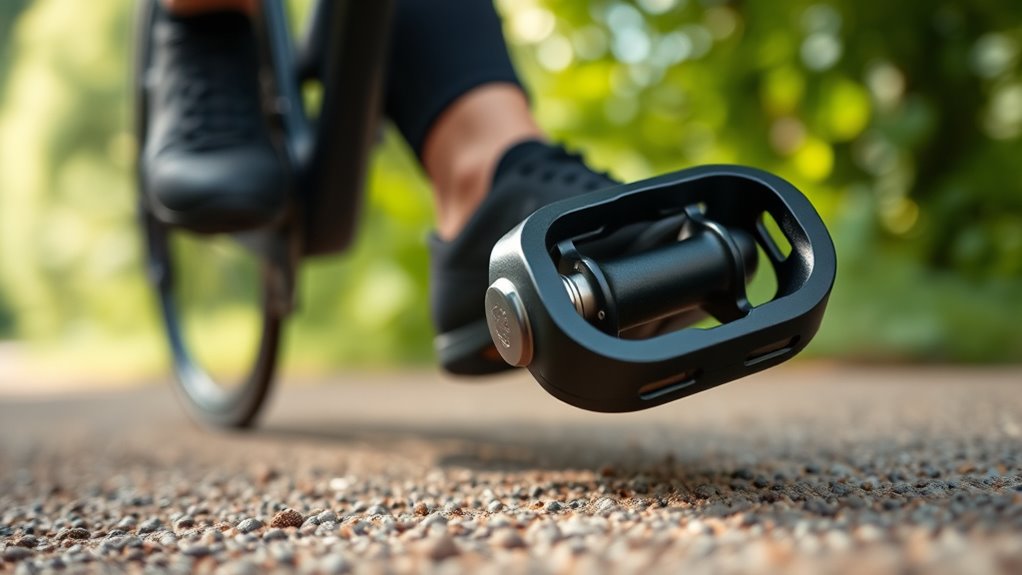
The pedal platform and engagement mechanism directly influence how comfortably and securely you connect with your pedals. A wider pedal platform offers more stability, making it easier to maintain control, especially during rough terrain or quick movements. A narrower platform provides a more streamlined feel, which some riders prefer for efficiency. The engagement mechanism determines how easily you clip in and release, impacting your confidence and safety. Some mechanisms require a firm twist to disengage, reducing accidental releases, while others offer quick, effortless disengagement. Consider how much force you prefer to engage or release your cleats. Choosing the right pedal platform and engagement mechanism helps ensure a comfortable, secure connection that matches your riding style and confidence level. Additionally, understanding the effectiveness of eye patches can be helpful when considering comfort and skin care during long rides or outdoor activities. Being aware of pedal material and design can also influence durability and weight, further enhancing your riding experience, especially when selecting components for performance enhancements. Incorporating knowledge about vibrational energy and how it affects your riding mindset can also contribute to a more positive and successful cycling experience. Recognizing how tuning techniques can optimize your bike’s responsiveness helps in customizing your riding experience to better suit your needs.
Evaluate Ease of Entry and Release

When selecting clipless pedals, it’s important to take into account how easily you can clip in and release. Look at the simplicity of the clip-in mechanism and whether you can adjust the release tension to suit your comfort. Practicing with different settings helps build confidence and ensures smooth, secure pedal engagement during rides. Additionally, considering features like adjustable release tension can make a significant difference in comfort and safety. Being aware of essential oils for safety and proper storage can also inform your overall approach to bike maintenance and comfort during riding. Understanding sound healing science and how it impacts mental focus can also contribute to a more mindful and relaxed riding experience. Knowing the role of necessary cookies in website functionality can help you better understand how user preferences are managed during online activities. Moreover, selecting pedals with easy entry and exit features can further enhance your riding experience by reducing the learning curve.
Clip-In Mechanism Simplicity
Evaluating the clip-in mechanism’s simplicity involves considering how easily you can step into and release from the pedals. The key factor is spring tension, which directly affects entry ease. If the tension is too high, you’ll struggle to clip in smoothly; too low, and the pedal may release unexpectedly. Look for pedals with adjustable spring tension so you can find a balance that suits your strength and riding style. A straightforward mechanism with a clear, intuitive release system makes it easier to disengage quickly when needed. When testing pedals, try clipping in and out multiple times to gauge how effortless the process feels. A simple, reliable clip-in mechanism enhances confidence and safety during rides, especially for beginners. Additionally, considering the notable titles in the realm of cycling gear can provide insight into the most trusted and highly-rated options available.
Release Tension Adjustment
Adjusting release tension directly impacts how easily you can clip in and out of your pedals. Proper tension adjustment allows you to find a balance between quick release and secure engagement. If your pedal tension is too high, you’ll struggle to unclip smoothly, risking falls or frustration. Conversely, if it’s too low, your foot may release unexpectedly, especially on rough terrain. Most pedals feature a tension adjustment screw or mechanism—use it to customize pedal tension to your preference and riding style. Regularly check and fine-tune this setting as you gain experience or change riding conditions. Remember, the right tension ensures safe, confident clipping and unclipping, making your ride more enjoyable and reducing the chance of accidental releases.
Practice for Confidence
Practicing how easily you can clip in and out builds confidence and helps you identify the ideal tension setting for your riding style. Spend time in a safe environment to evaluate how smoothly you can engage and release your pedals. Regular gear maintenance ensures the mechanisms function properly, preventing unexpected sticking or slipping. Adjust the tension if needed, using pedal customization options to match your comfort level. This hands-on practice allows you to refine your technique, reducing hesitation during rides. Focus on consistency in your clipping and unclipping motions. Over time, you’ll develop muscle memory, making transitions seamless. Remember, confidence comes from familiarity, so dedicate time to practice until you feel secure with your pedal setup. Incorporating proper yoga practices can also improve your flexibility and focus, aiding in smoother clip-in and clip-out techniques. Additionally, understanding bike shop hours can help you plan visits for any adjustments or maintenance needed to optimize your pedals. Knowing about clipless pedal technology can further enhance your ability to troubleshoot and fine-tune your system effectively. Developing a regular practice routine can further reinforce your skills and ensure consistent performance.
Think About Weight and Durability
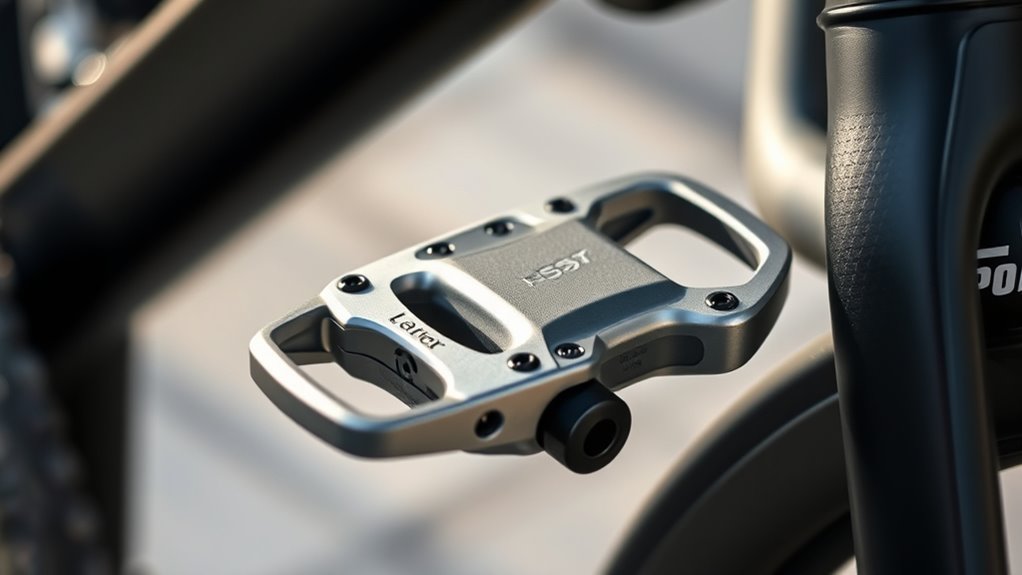
When choosing clipless pedals, considering weight and durability is vital to guarantee they match your riding style and needs. Weight considerations directly impact your performance, especially during climbs or long rides, so lighter pedals can reduce fatigue. Durability factors determine how well the pedals withstand wear and tear over time, which is essential if you ride frequently or in tough conditions. Look for materials like aluminum or composite for a good balance of weight and strength, but keep in mind that lighter pedals might sacrifice some durability. Conversely, heavier steel pedals tend to last longer but add weight. Assess your riding terrain and frequency to find the right balance that offers longevity without unnecessary weight. Prioritizing these aspects ensures your pedals serve you well without regret.
Match Pedal Feel With Your Personal Preference

Choosing pedals that feel right to you can substantially enhance your riding experience. To do this, consider how pedal resistance and pedal float align with your preferences. First, assess your comfort with pedal resistance: lower resistance allows for easier clipping in and out, ideal for beginner or casual riders. Second, evaluate pedal float—the degree of lateral movement—since more float offers greater freedom but less stability. Third, test different pedal types to find your sweet spot: some riders prefer minimal float with firm resistance for efficiency, while others favor more float and softer resistance for comfort. Matching these elements to your riding style ensures you stay comfortable and confident, making your ride more enjoyable and reducing the risk of discomfort or injury.
Set a Realistic Budget for Your Purchase
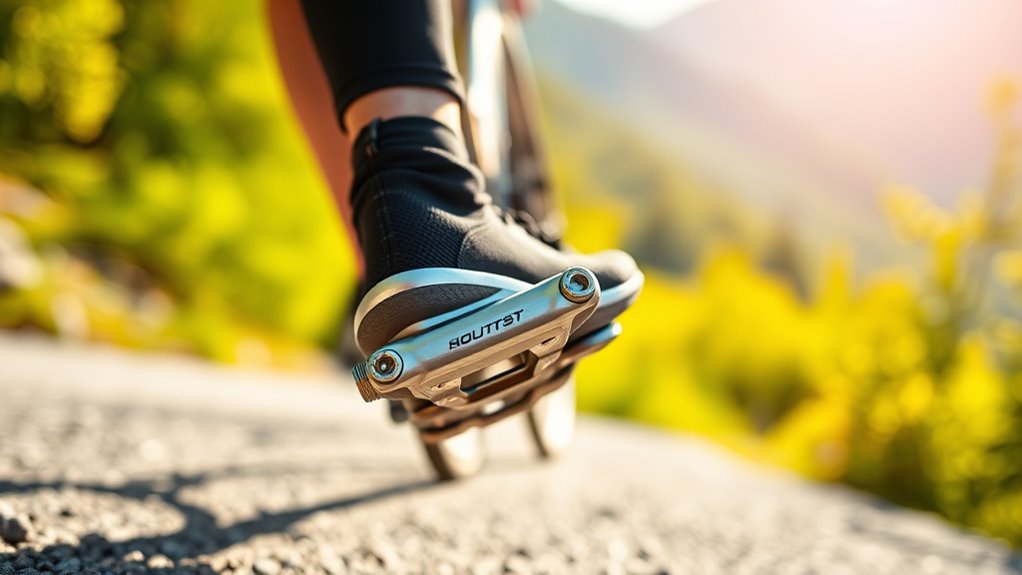
Setting a realistic budget is essential to guarantee you find clipless pedals that meet your needs without overspending. Determine your ideal price range based on how often you’ll ride and your riding goals. Keep in mind that higher-priced pedals often come from reputable brands with proven durability and quality, which can justify the investment. However, brand reputation isn’t everything—some lesser-known brands offer excellent value and performance at lower prices. Set a clear limit to avoid impulse buys and identify options within your budget that provide the features you need. Remember, you don’t have to break the bank to get reliable clipless pedals; balancing your desired features with your budget ensures satisfaction and long-term use.
Test Before You Commit to a Purchase
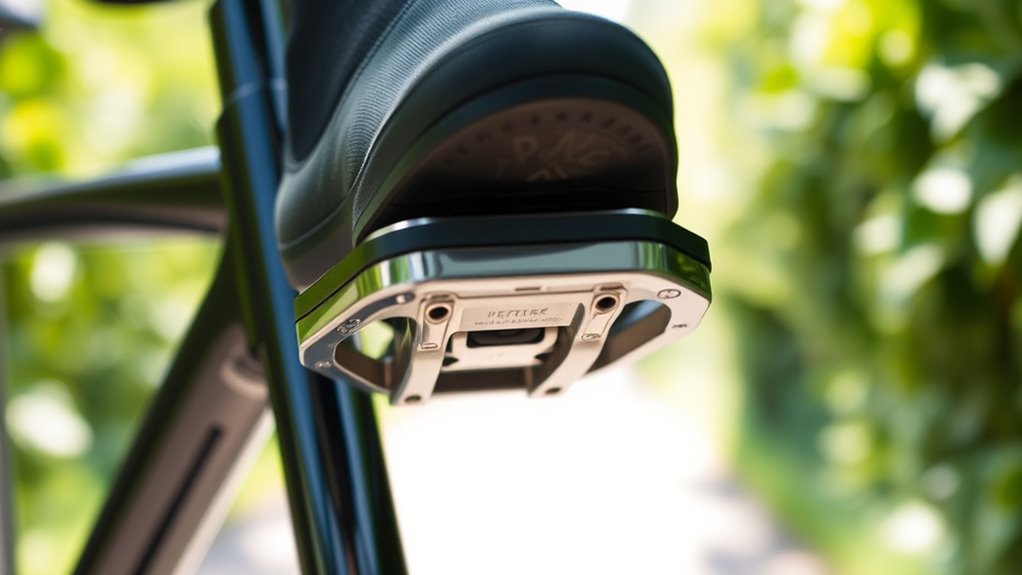
Before making a final decision, it’s essential to test out different clipless pedals to see how they feel and perform during your rides. This step helps you assess ergonomic comfort and pedal aesthetics, guaranteeing they suit your riding style. When testing, focus on these key aspects:
- Ergonomic Comfort: Make sure the pedal provides proper support, reducing fatigue on long rides.
- Ease of Engagement and Release: Check if you can clip in and out smoothly without hesitation.
- Aesthetic Appeal: Choose a design that complements your bike’s look and matches your personal style.
Take your time during test rides, switching between models to gauge which pedal offers the best balance of comfort, functionality, and visual appeal. This ensures you’ll make a confident choice.
Frequently Asked Questions
How Do I Determine the Best Clipless Pedal for My Riding Terrain?
To determine the best clipless pedal for your riding terrain, consider pedal compatibility with your bike and shoes. Think about your riding style—mountain biking, road cycling, or commuting—and choose pedals that suit that terrain. Also, look at pedal weight; lighter pedals reduce fatigue on long rides. Testing different models helps you find the right balance of security, comfort, and performance, ensuring you enjoy your ride without regrets.
What Safety Features Should I Look for in Clipless Pedals?
Thinking about safety features in clipless pedals? Well, you’ll want pedals with reliable pedal locking so you don’t take a tumble. Look for adjustable release tension—because nobody wants to be stuck in the pedals during a quick stop. Bonus points for pedals that release smoothly and easily, ensuring you stay upright rather than doing a dramatic faceplant. Safety first, and yes, that includes a good release tension!
Can I Switch Between Clipless and Platform Pedals Easily?
Switching between clipless and platform pedals is usually straightforward, but you need to verify pedal compatibility first. Many clipless pedals work with different cleat systems, making it easier to switch. Keep in mind that gear shifting might need adjustment if your riding style changes. You can often swap pedals quickly, but it’s best to confirm your shoes are compatible and that your bike’s setup supports easy transitions.
How Often Should I Replace or Service My Clipless Pedals?
Think of your pedals as the heartbeat of your ride; they keep you moving smoothly. You should perform regular pedal maintenance and check for wear every few months, depending on your riding frequency. Replacement frequency varies—typically every 2,000 to 3,000 miles or when you notice looseness, squeaking, or decreased performance. Staying attentive guarantees your pedals stay reliable, preventing unexpected issues and keeping your cycling experience seamless.
Are There Specific Brands Known for Durability and Comfort?
When selecting clipless pedals, you’ll find that brands like Shimano, Look, and Time have strong reputations for durability and comfort. Consider their brand reputation and pedal material—aluminum for lighter weight and durability, or composite for affordability. You want pedals that perform well under various conditions and last over time. By choosing reputable brands with quality materials, you guarantee a comfortable ride with reliable performance and fewer regrets down the line.
Conclusion
Choosing the right clipless pedals can elevate your riding experience, but it’s about more than just features—it’s about how well they fit your style and goals. Have you considered how each factor aligns with your needs? Take your time to test and reflect before buying; a well-chosen set boosts confidence and enjoyment. After all, isn’t investing in the right gear the key to truly enjoying every ride?
